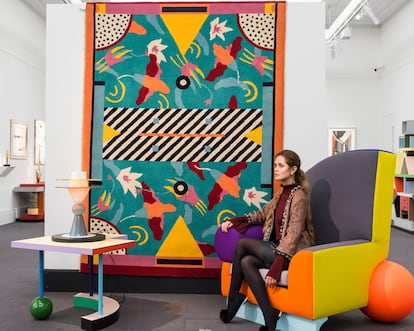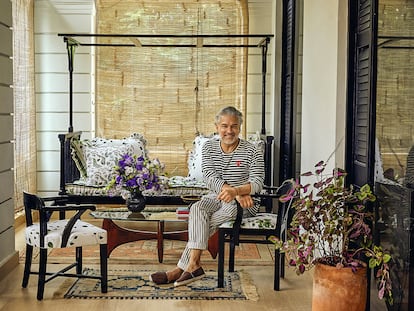The end of ‘sedative spaces’: These are the interior design trends that will sweep 2024
We’re seeing the return of stainless steel, the cult of the Modern Movement of architecture, the practice of ‘upcycling’ and color above all. Six interior design studios reveal the keys to modernizing our homes this year

The interior design game has changed. If the pandemic brought with it an unprecedented new look at our homes — with the search for versatile spaces in which to work, rest and partake in leisure — the end of it has broken the established rules. Now, it’s time to dream and live big.
The war on dull colors, impersonal furniture and omnipresent wood are some clues that experts in the field provide to find a magazine-worthy interior design. If one of your New Year’s resolutions is to renovate your home, you should discover what to bet on — and what to throw away — when it comes to interior design in the coming months.
Goodbye to neutral tones, hello to burgundy and orange
While the Pantone Color Institute is advocating for a soft and calm year with its 2024 shade — Peach Fuzz (a kind of pastel) — experts in the field are clear that, in the coming months, we will embrace a palette with much more personality.
Fabián Ñíguez, an interior designer recognizable for his eclectic taste, specifies that the excess of gray and white has its days numbered. “[These colors] were trendy for a while, but now they’re monotonous and lacking personality. This style often led to excessive minimalism, leaving spaces without character. [Gray and white] are colors that provide neutrality and relaxation. They form a perfect canvas for sculpting scenarios, but alone, they’re being left aside.” To break this monotony, the interior designer recommends incorporating vibrant colors or decorative elements that add vitality to the environment, whether through a prominent piece of furniture — such as a table or sofa in a warm tone — or by applying color to the kitchen tiling.
Alba Vázquez Codesido — an architect who specialized in the renovation of private homes during the pandemic — bets everything on a winning color. “The serenity of terracotta, pink and makeup colors hasn’t yet left the interiors, but there’s an evolution towards burgundy in its most sober form.” The Spanish architect adds oranges and reds (in their brightest versions) to this chromatic list. “If we combine them with textured, rough and natural materials, the result will be [complete].” And, if one wishes to embrace a more risky proposal, Vázquez suggests adding touches of electric blue to the warm combination, in the form of kitchen furniture or room dividers. “It seems to me to be a very [interesting] combination that we should explore in 2024.”
A home will be sustainable or it will not be
The small daily gestures that we’ve been practicing for decades — such as choosing low-consumption light bulbs and appliances, or encouraging recycling — have given way to a global emergency that also concerns the interior design of our home. “It’s important that we practice conscious sustainability, applied both in materiality and in ways of life. We have to believe in it first and then bring it to our environment… and, in this case, to the homes we design,” affirms Lorna de Santos, an interior designer who works with recycled materials and natural, handmade fabrics. Some of the textures she utilizes are made with dust from marine debris.
De Santos — who has just designed Bascoat, a trendy new restaurant in Madrid — offers some quick recommendations to put this into practice. “We have to ensure that reused or low-impact materials have a lower cost, so that we can make use of them. We have to consider energy efficiency as a long-term investment that’s conscious and committed to our natural environment… Without [greenspace], we wouldn’t be able to disconnect. And we need this, given the frenetic life that we lead.”
Raúl Martins — famous for his classic and vibrant style that enchants distinguished residences in Madrid, Paris and London — brings sustainability within everyone’s reach with some easy-to-execute strokes. “I advise eliminating dark colors, especially on surfaces such as walls and ceilings. This is a way to save energy, because they absorb light and force us to use more electricity. Additionally, they take away the optimism of the spaces — [dark colors] make them visually hard and create a very untrendy atmosphere.”
The interior designer is immersed in special projects, such as the renovation of a castle south of Paris and a modern villa in Estoril, Portugal. He points to upcycling as a beautiful and sometimes economical way to recycle and generate less waste in the decoration of a home. “My idea is to encourage people to take a nice vintage armchair and incorporate it into the living room. There are many antique stores, flea markets, or even online stores where you can look for them and give them a new life, with a fabric made from recycled elements.”
“At the beginning of the year, I presented a collection of textiles with some designs made with PET (Polyethylene Terephthalate, a common plastic). This is how we fulfill the three Rs: reduce, reuse and recycle.”
An extravagant chandelier or mirrors
Minimalism’s days are numbered. As we pointed out at the beginning of this piece, the sedative colors have given free rein to a scenario open to play and daydreaming. For interior designer Fabián Ñiguez, the esthetic crux of 2024 lies in not discarding anything, enlivening the heterogeneous and applauding theatricality.
“I like to work with eclectic maximalism,” she explains, “a decorative trend that combines different styles, colors and textures to create a striking environment and dramatic [scene] that has been gaining ground in recent years.”
To apply it successfully, the professional continues, just follow these simple tips: “Try combining different styles of furniture and accessories to create a unique and personalized space. For example, you can mix a modern coffee table with an antique chandelier.” Adding different textures to the home’s textiles, or incorporating a striking element that adds drama to the space and helps unify it — such as a large, colorful work of art or an extravagant mirror — are other recommendations from the interior designer. And we can’t forget to play with color. “Eclectic maximalism is about being bold with colors. Don’t be afraid to mix bright and bold shades. You can use cushions, curtains, rugs and other accessories to add color to your space.”
Interiors with personality
A place where we feel more like ourselves than ever: this will be the objective, according to Carlos Tomás, founder of EstudioReciente. He has created a transversal design concept for residences and private spaces. “This idea of the home as a nest and shield of peace against the world will lose strength — it will be more of a refuge for our values than just for our lives. Hence, the local has to be noticed in the interiors, through the use of colors, materials and construction solutions. The interiors shouldn’t sedate us, as they’ve been doing until now. Rather, they should motivate us,” the interior designer says.
To ground the trend in a future renovation, Carlos advises opting for a more uninhibited use of color and the combination of materials with metallic effects, stones, marbles and local woods, shifting away from the ubiquitous natural oak. It’s a forceful response, the expert explains, to the trend that has reigned during the last decade, of promoting the standardization of color and materials to fit into the speculative system of home value. “In the United States, it provoked a very strong movement against uniformity. Everyone likes the idea of [uniformity], so that when [the property] goes on sale, it will have more value. But, in the end, what [non-monetary] value does it have for the owner?” he reflects.
Out with wood paneling, welcome stainless steel
The second decade of this century will be remembered for the repeated search for inspiration in nature to conceive our long-awaited refuge. From the organic and curvilinear shapes in sofas and other pieces of furniture, to the stucco on walls that imitates sand, to the omnipresence of wood in every nook and cranny of the home. “It’s a difficult affiliation to discard. This doesn’t mean that straight lines now prevail above all, but the fever for ‘organic’ has its days numbered. Now, it will be integrated in a more subtle way, instead of dominating everything,” explains Spanish interior designer Alba Vázquez Codesido.
This trend, Carlos Tomás adds, can be perceived, above all, in the use of materials with greater visual presence and character: “We’ll see a lot of stainless steel, aluminum and chrome. We don’t see as much gold or brass anymore. In a juxtaposition, there’s also a return to marble and wood, but [the use of it is] interpreted in a different way from that decadent luxury of the 1990s. Now, they return to stimulate the sense of touch in the new interiors.” The kitchen is the favorite room when it comes to applying this penchant for cold materials, as an alternative to the interior carpentry of recent years.
Looking back: mastery of 20th century finishes and icons
The old is more alive than ever. For Ana Arana and Enrique Ventosa — founders of the Plutarco architecture studio — it’s clear that the success of good interior design involves looking back and learning from the masters. “We’ve always been great defenders of Le Corbusier, Aalto, Charlotte Perriand and Eileen Gray… but there’s now a clear tendency to look at the work of these pioneers of the Modern Movement in the 1930s. Their way of understanding space and interior design in simple rooms — which were refined with color planes and different mixes of materials — is very present,” they reflect.
Take note of the tiled walls outside the kitchen and bathrooms in the French villa E-1027. Between 1926 and 1926, in Roquebrune, France, Eileen Gray planned the high-gloss ceilings. These were subsequently applied to the Paimio Sanatorium by Finnish architect Alvar Aalto, the lattices and walls that make up Marseille’s Housing Unit, as well as the color compositions in Villa La Roche in Paris. The latter two projects — both designed by iconic Swiss-French architect Le Corbusier — were a strong inspiration for the interior design to come. “It’s no coincidence that these elements are increasingly present in our interiors. We believe they will continue to be so in 2024,” Arana and Ventosa emphasize.
As a masterstroke, the experts recommend completing the space with iconic pieces of furniture, “but mixed with other more contemporary pieces, such as anything by Muller Van Severen, the Bouroullec brothers or Inga Sempé… They’ll always be a success and it’s a way to [give an overview] of the Modern Movement.” And, on a more down-to-earth level, we can do this by combining color planes in space-dividing elements, such as a lattice to separate the dining room from the living room, or the bedroom from the dressing room. In addition to fulfilling their function, these dividers provide a strong architectural presence to a space. “It’s an easy way to bring a change to your home; it’s also reversible and easy to modify and adapt.”
A fully-tiled house
As indicated by those at the Plutarco architecture studio — and as already predicted by Eileen Gray, the pioneering Irish architect and furniture designer — covering the walls with tiles shouldn’t only happen in the bathroom and the kitchen. Arana and Ventosa — who are designing the common and private areas for a luxury hotel in Ibiza — make it clear that tiled walls will experience their golden age in 2024. “They’re at their maximum splendor.”
The postmodern tiles of Nathalie Du Pasquier, or the pioneering work of Studio GdB — with its personalized tiling that combines technology and fine craftsmanship — are a very trendy option that can be applied to any partition in a house. “Studio GdB creates unique pieces in color gradients that remind us of the tiling of the 1970s, but brought to the present day.” The architects emphasize the infinite possibilities that exist to apply this type of color pattern in our homes, providing dynamism in every corner. “It’s also a very easy trend to apply on a surface that you want to personalize, such as a living room, a bedroom headboard, or a bathroom cabinet.”
Sign up for our weekly newsletter to get more English-language news coverage from EL PAÍS USA Edition
Tu suscripción se está usando en otro dispositivo
¿Quieres añadir otro usuario a tu suscripción?
Si continúas leyendo en este dispositivo, no se podrá leer en el otro.
FlechaTu suscripción se está usando en otro dispositivo y solo puedes acceder a EL PAÍS desde un dispositivo a la vez.
Si quieres compartir tu cuenta, cambia tu suscripción a la modalidad Premium, así podrás añadir otro usuario. Cada uno accederá con su propia cuenta de email, lo que os permitirá personalizar vuestra experiencia en EL PAÍS.
¿Tienes una suscripción de empresa? Accede aquí para contratar más cuentas.
En el caso de no saber quién está usando tu cuenta, te recomendamos cambiar tu contraseña aquí.
Si decides continuar compartiendo tu cuenta, este mensaje se mostrará en tu dispositivo y en el de la otra persona que está usando tu cuenta de forma indefinida, afectando a tu experiencia de lectura. Puedes consultar aquí los términos y condiciones de la suscripción digital.
More information
Últimas noticias
Most viewed
- Reinhard Genzel, Nobel laureate in physics: ‘One-minute videos will never give you the truth’
- Oona Chaplin: ‘I told James Cameron that I was living in a treehouse and starting a permaculture project with a friend’
- Pablo Escobar’s hippos: A serious environmental problem, 40 years on
- Chevy Chase, the beloved comedian who was a monster off camera: ‘Not everyone hated him, just the people who’ve worked with him’
- Why we lost the habit of sleeping in two segments and how that changed our sense of time











































